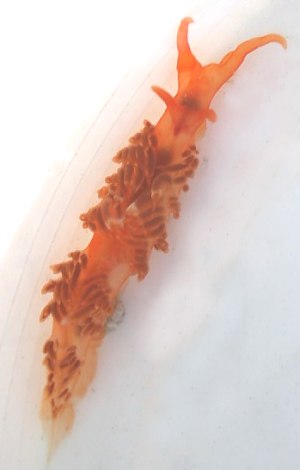
Phidiana lascrucensis
Bertsch & Ferreira, 1974
Order: NUDIBRANCHIA
Suborder: AEOLIDINA
Family: Glaucidae
DISTRIBUTION
Pacific coast of Central America.
PHOTO
Los Arcos, Bahia de Banderas, Pacific Coast of Mexico. Photo: Alicia Hermosillo
Body translucent orange to orange yellow, and sometimes almost white with little sign of orange. The rhinophores and oral tentacles are also orange and when not damaged have a white tip. A variable number of white specks are scattered over the dorsum. The cerata are translucent clear with the dark brown digestive gland showing through the ceratal wall. There can be a white band about two-thirds of the way up each ceras and a white tip. The rhinophores are slightly shorter than the longest cerata and have about 15 distinct annulations in larger specimens. The cerata are arranged in rows as can be seen in accompanying photo. Found from the intertidal to about 20m, and grows to about 25mm long.
Reference:
• Bertsch, H. & Ferreira, A.J. (1974) Four new species of nudibranchs from tropical west America. The Veliger, 16(4): 343-353.
Rudman, W.B., 2002 (April 4) Phidiana lascrucensis Bertsch & Ferreira, 1974. [In] Sea Slug Forum. Australian Museum, Sydney. Available from http://www.seaslugforum.net/find/phidlasc
Related messages
Predation on sea slugs
April 25, 2002
From: Alicia Hermosillo

Dear Dr. Rudman,
I was reading the posts on 'what eats sea slugs??'. I wanted to share something.
Last February, as I was surveying in Los Arcos, Bahia de Banderas, Pacific Coast of Mexico, I turned a rock and saw 3 specimens of Phidiana lascrucensis Bertsch & Ferreira, 1974 under it. As I was measuring and writing down observations, a damselfish came by and ate one of them. I thought it would spit it out like they usually do, but it did not.
I thought this was very strange, then I read in Mike Miller´s Slug Site, on Nudibranch of the Week 31. Han´s tale of finding this species for the first time, and it turns out one of his specimens was eaten by a fish as well.
Alicia
gueri25@hotmail.com
Hermosillo, A. , 2002 (Apr 25) Predation on sea slugs. [Message in] Sea Slug Forum. Australian Museum, Sydney. Available from http://www.seaslugforum.net/find/6682Thanks Ali,
Any little bit of information is valuable. I guess most cases of predation on nudibranchs goes unnoticed. As I have said before, without hard parts, most opisthobranchs are unidentifiable in stomach contents. Fish often fish 'mouth' nudibranchs, moving them around in their mouths, sometimes spitting them out, but sometimes persisting until the nudibranch has exhausted its supply of nasty chemicals, nematocysts etc, then they eat them. Bertsch & Ferreira (1974), in their original description of this species also report that Navanax inermis ate an animal in aquarium.
Best wishes,
Bill Rudman
